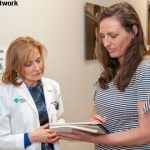The First Knot: Select the Site
Prior to opening the Center of Integrated Care, members of my team and I engaged with various stakeholders to solicit their views and experiences: These stakeholders included primary care physicians, community rheumatologists, researchers (in particular, members of the Outcomes Measures in Rheumatology special interest group of shared decision making), hospital representatives and patient support groups, such as the Arthritis Society, Osteoporosis Society and the Canadian Rare Disease Organization.
I made plans to transition my practice from a downtown teaching hospital to a non-medical building complex close to a pain center to ensure my patients could have timely access to pain treatments beyond my scope of practice. The complex allowed for street level access to my clinic for those with disabilities, as well as ample free parking.
My new catchment area serves 1.9 million people, many of whom have a high level of chronic disease. Despite this, this population is served by relatively few specialists. This area includes an indigenous community; 47% of its residents are minorities, and 12.5% of the people are older than 65.27
The dichotomy of the demographic profile in this area has grown: on one side are families supported by single providers, which have the lowest incomes; on the other side are some of the richest neighborhoods in the greater Toronto area.
During the center’s development, I took a drive with a local real estate agent to learn about the living patterns of potential patients: where they might work, where they might live, where they would shop for groceries, what restaurants they might frequent and what recreational facilities were available to them (e.g., ice rinks and baseball facilities). If this model were to be fully integrated, it would be necessary to reduce the gaps in rheumatic disease care often caused by socioeconomic factors and other barriers to care.
High-quality integrated care is a model in which a holistic consideration passes through an evidence-based filter & is narrowed to practical options presented to the empowered patient for shared decision making.
The Second Knot: Establish Holistic Care
Our patients are more than just patients, and medicine includes everything from the food we eat to the love we receive, the availability and suitability of shelter, the strength of our relationships, our emotional health and our sense of self. Our approach to care must be holistic and take the entire person and patient experience into consideration.
I was unaware of what holistic truly meant until I read further on the subject. I can tell you there is nothing touchy-feely about this strategy: It is not a throwback to the hippie era, nor is it a way to generate revenue by incorporating wellness fads into your practice. These fads have destroyed the essence of what holistic care means. Being holistic does not mean exploring only non-pharmaceutical interventions.
When I speak of being holistic with regard to treating rheumatic diseases, it is a commitment to systematically address the physical (disease-specific), socioeconomic and local healthcare realities to achieve disease-specific and patient-centered care goals. For this approach to succeed, the following are essential:


